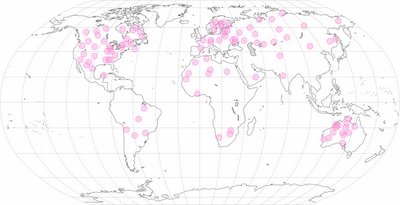
On the surface, Earth doesn’t look nearly as abused as Mercury or the Moon. However, the earth has been struck by more than 10 times the amount of impacting objects. Over time this has produced approximately 3 million impact craters from 1 km in diameter to more than 1000 km in diameter. You would never see evidence of these impacts by simply studying the Earth’s surface due to geologic processes such tectonic plate subduction, mountain building, erosion, and volcanism. Mountain building crumples impact craters, plate subduction consumes them, erosion d
 issects them, and lava flows and sediments often bury them. These events essentially mask the effect of impact craters on our planet. As a result, only about 160 surviving impact craters have been found and documented so far. The most famous of these 160 impact craters is the 180 km diameter Chicxulub impact crater on the Yucatan Peninsula of Mexico. Studies of this crater and the mass extinction event that occurred on Earth 65 million years ago have shown that impact cratering can affect both the biologic and geologic evolution of a planet. A much better record of what the Earth might look like without its surface changing events can be seen on the Moon because there is no water on its surface, lava no longer erupts from its volcanoes, and plate tectonics have never occurred there. There are over 300,000 impact craters about 1km in diameter on the Moon. Parallels can be drawn between the Earth and the Moon because the craters on the Moon have been created as asteroids and comets hit its surface, and at the same time similar objects hit the Earth. From the Moon’s impact history we can conclude that due Earth's larger size, it would have suffered about 10 times more impact events, or over 3 million impact craters greater than 1 km in diameter.
issects them, and lava flows and sediments often bury them. These events essentially mask the effect of impact craters on our planet. As a result, only about 160 surviving impact craters have been found and documented so far. The most famous of these 160 impact craters is the 180 km diameter Chicxulub impact crater on the Yucatan Peninsula of Mexico. Studies of this crater and the mass extinction event that occurred on Earth 65 million years ago have shown that impact cratering can affect both the biologic and geologic evolution of a planet. A much better record of what the Earth might look like without its surface changing events can be seen on the Moon because there is no water on its surface, lava no longer erupts from its volcanoes, and plate tectonics have never occurred there. There are over 300,000 impact craters about 1km in diameter on the Moon. Parallels can be drawn between the Earth and the Moon because the craters on the Moon have been created as asteroids and comets hit its surface, and at the same time similar objects hit the Earth. From the Moon’s impact history we can conclude that due Earth's larger size, it would have suffered about 10 times more impact events, or over 3 million impact craters greater than 1 km in diameter.

No comments:
Post a Comment